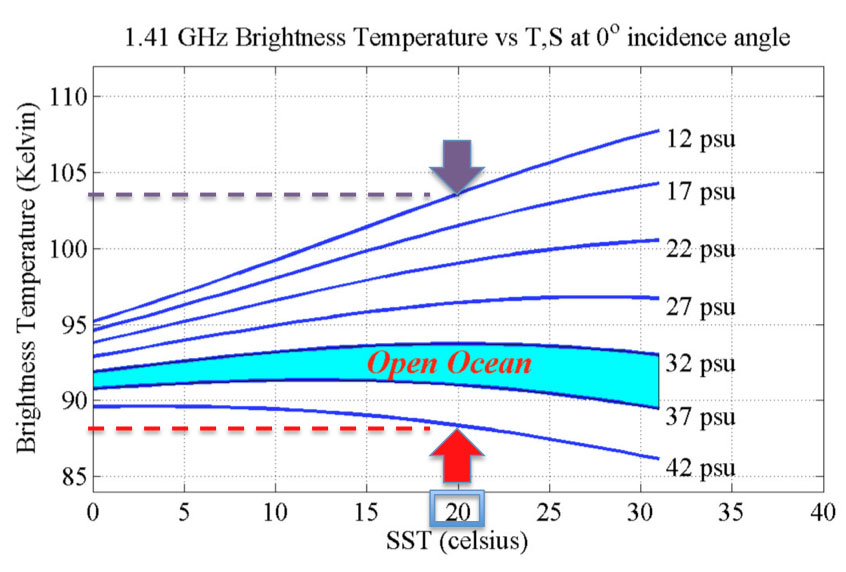Overview: Frequently Asked Questions
FAQ Category: Aquarius Instrument
Can you explain "brightness temperature"?
What we're measuring is natural radiation from the ocean surface. Everything has energy because it's not at absolute zero temperature and thus gives off radiation. An example of that is night vision. The military is able to see people at night not because they look at light but because they look at infrared radiation. The people are giving off energy at lots of frequencies. One of those (frequencies) is slightly below the optical and is called "infrared" and we use night vision to see that.
Another example of natural radiation is the heating of your electric stove. You turn on the burner, it warms up, and it glows red because it has gotten more energy and the added energy changes its frequency distribution. Now because it's so hot, it actually gives off more energy in the optical frequencies that our eyes are sensitive to. But it is also putting off radiation at all frequencies. So if we looked at it with night vision, then it would be overwhelmingly bright. And if you looked at it in the microwave frequency range (e.g., 1.41 GigaHertz, GHz like the Aquarius instrument measures), it would also look very bright. So it's giving off energy.
We talk about that energy as an equivalent temperature. So you can say that if the temperature is higher, there is more energy and if the temperature is lower, then there is less energy. The scale isn't so important because it depends on the frequency (e.g., the same temperature scale wouldn't work for the night vision scale at the infrared frequencies). But we have a scale called "Brightness Temperature" that is measuring the amount of energy that's being given off by the ocean surface at a fixed temperature.
So in the graph above right (click image to enlarge), go along the horizontal axis and stop at a sea surface temperature (SST) equal to 20 degrees Celsius (see blue box). If you go up to the blue line labeled "12 psu" (practical salinity units, psu), you'll see a purple arrow. If you read across to the vertical axis (i.e., follow the purple dashed line to the left), you see that lower salinity water gives off higher energy because the Brightness Temperature is about 104. At that same SST of 20 degrees Celsius, higher salinity water (see red arrow at 42 psu), gives of relatively lower energy (i.e., follow the red dashed line to Brightness Temperature on the vertical axis at about 88).
Aquarius has a very precise instrument that tells us how much energy is coming off the ocean surface and we express that as a "Brightness temperature". If the brightness temperature is higher, then the seawater is fresher (i.e., less salty; see pruple arrow / dashed line above). If the brightness temperature is lower, then the seawater has more salt (i.e., red arrow / dashed line). The graph shown at right was published in 1977. So an important new area of research is to develop a set of curves that are very carefully calibrated so we know exactly what energy corresponds to what salinity. And the instrument we use is very precise and makes these measurements accurately and consistently.
Another example of natural radiation is the heating of your electric stove. You turn on the burner, it warms up, and it glows red because it has gotten more energy and the added energy changes its frequency distribution. Now because it's so hot, it actually gives off more energy in the optical frequencies that our eyes are sensitive to. But it is also putting off radiation at all frequencies. So if we looked at it with night vision, then it would be overwhelmingly bright. And if you looked at it in the microwave frequency range (e.g., 1.41 GigaHertz, GHz like the Aquarius instrument measures), it would also look very bright. So it's giving off energy.
We talk about that energy as an equivalent temperature. So you can say that if the temperature is higher, there is more energy and if the temperature is lower, then there is less energy. The scale isn't so important because it depends on the frequency (e.g., the same temperature scale wouldn't work for the night vision scale at the infrared frequencies). But we have a scale called "Brightness Temperature" that is measuring the amount of energy that's being given off by the ocean surface at a fixed temperature.
So in the graph above right (click image to enlarge), go along the horizontal axis and stop at a sea surface temperature (SST) equal to 20 degrees Celsius (see blue box). If you go up to the blue line labeled "12 psu" (practical salinity units, psu), you'll see a purple arrow. If you read across to the vertical axis (i.e., follow the purple dashed line to the left), you see that lower salinity water gives off higher energy because the Brightness Temperature is about 104. At that same SST of 20 degrees Celsius, higher salinity water (see red arrow at 42 psu), gives of relatively lower energy (i.e., follow the red dashed line to Brightness Temperature on the vertical axis at about 88).
Aquarius has a very precise instrument that tells us how much energy is coming off the ocean surface and we express that as a "Brightness temperature". If the brightness temperature is higher, then the seawater is fresher (i.e., less salty; see pruple arrow / dashed line above). If the brightness temperature is lower, then the seawater has more salt (i.e., red arrow / dashed line). The graph shown at right was published in 1977. So an important new area of research is to develop a set of curves that are very carefully calibrated so we know exactly what energy corresponds to what salinity. And the instrument we use is very precise and makes these measurements accurately and consistently.
